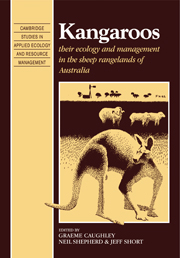Book contents
- Frontmatter
- Contents
- Preface
- Dedication
- THE STUDY AREA IN CONTEXT
- 1 Introduction to the sheep rangelands
- 2 The environment of the Australian sheep rangelands
- 3 The effect of weather on soil moisture and plant growth in the arid zone
- 4 Plant dynamics
- 5 The diet of herbivores in the sheep rangelands
- 6 Factors affecting food intake of rangelands herbivores
- 7 The mobility and habitat utilisation of kangaroos
- 8 Kangaroo dynamics
- 9 Condition and recruitment of kangaroos
- 10 Ecological relationships
- 11 Options for management of kangaroos
- Appendices to Chapter 8
- REFERENCES
- Author index
- Subject index
4 - Plant dynamics
Published online by Cambridge University Press: 05 November 2011
- Frontmatter
- Contents
- Preface
- Dedication
- THE STUDY AREA IN CONTEXT
- 1 Introduction to the sheep rangelands
- 2 The environment of the Australian sheep rangelands
- 3 The effect of weather on soil moisture and plant growth in the arid zone
- 4 Plant dynamics
- 5 The diet of herbivores in the sheep rangelands
- 6 Factors affecting food intake of rangelands herbivores
- 7 The mobility and habitat utilisation of kangaroos
- 8 Kangaroo dynamics
- 9 Condition and recruitment of kangaroos
- 10 Ecological relationships
- 11 Options for management of kangaroos
- Appendices to Chapter 8
- REFERENCES
- Author index
- Subject index
Summary
Introduction
This chapter explores the following questions about vegetation in the sheep rangelands:
(1) How does rainfall affect plant biomass?
(2) How do rainfall and plant biomass affect plant growth?
(3) How does soil texture affect plant biomass?
(4) How does grazing by kangaroos and sheep affect plant biomass?
(5) Do any of these factors dominate to explain trends in plant biomass and species composition?
These questions will be addressed using data derived from Kinchega and Tandou. Pasture and shrubs are dealt with separately. Pasture includes all vascular plants in the herbaceous layer including chenopod sub-shrubs. Shrubs occupy the mid-layer of the vegetation and comprise perennial, deep-rooted, long-lived species relatively resistant to drought. The major shrub species is black bluebush (Maireana pyramidata), a 1.5 m high chenopod shrub not very palatable to kangaroos and sheep but eaten in times of severe food shortage.
Research methods
Pasture measurements
Pasture biomass and species composition were measured and species phenology was recorded at 213 sites on Kinchega National Park and at 100 sites on Tandou for each quarter between August 1980 and February 1984. Sites were located 1 km apart on parallel east-west lines separated by 2 km.
On each sampling occasion the pasture was measured at each site on three 0.25 m2 circular plots positioned at random within the site. These plots were then caged to exclude grazing by kangaroos, sheep and rabbits and were remeasured three months later.
- Type
- Chapter
- Information
- KangaroosTheir Ecology and Management in the Sheep Rangelands of Australia, pp. 50 - 68Publisher: Cambridge University PressPrint publication year: 1987
- 17
- Cited by



